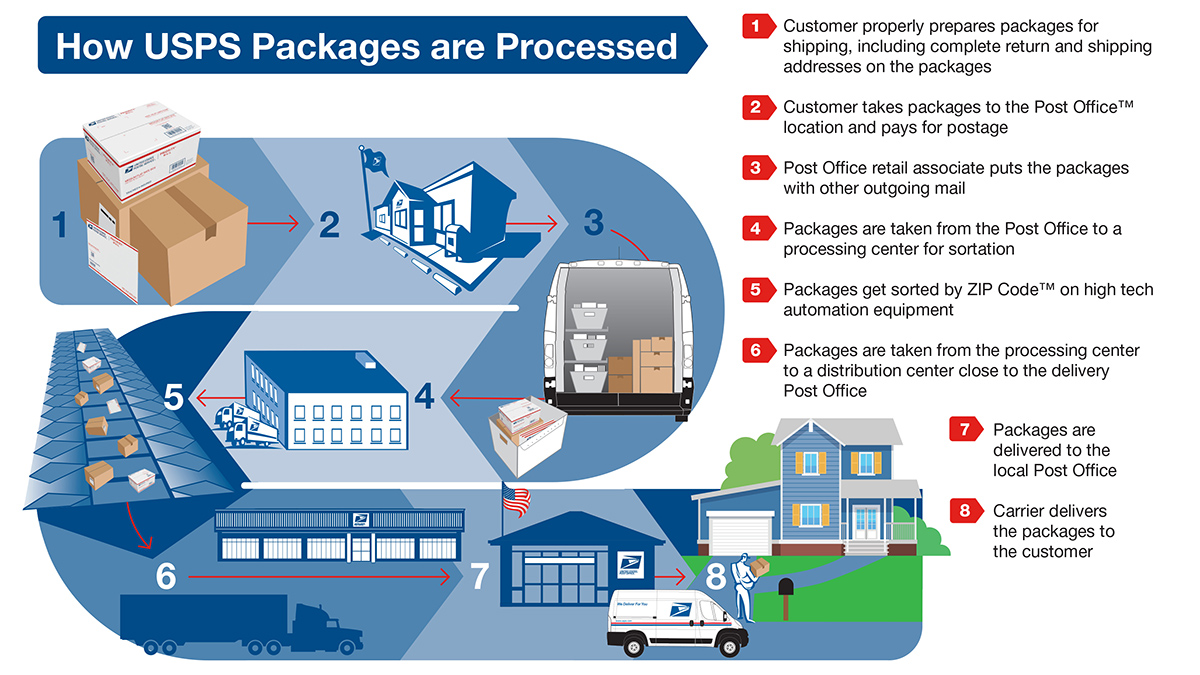*Delivering mail from beginning to end

Ever wonder what happens to your mail and packages after you put them in the mailbox or drop them off at a Post Office?
Whether across town, or across the country, the route your mail travels is more involved than just “over the river, and through the woods.”
The United States Postal Service has nearly 34,000 Post Office locations and more than 300 processing and distribution facilities across the country. The extensive USPS network processes nearly 182 million pieces of First-Class Mail every day.
Once you place your packages, letters, or greeting cards in the mail — through your mailbox at home, a blue collection box, or a local Post Office — Postal Service employees will gather everything up and begin moving it through our network.

After collection, the mail and packages are moved to processing facilities. At the processing facilities, the mail is separated into three categories — letters, flats, and packages. Once separated, machines are used to sort the mail by ZIP Code. Machines convert images of mailpieces into data by using cameras that take pictures to gather the destination address, tracking barcode (applied at the facility), and postage. This data is used to sort the mail, create tracking information and validate the postage amount.
Because packages come in a variety of shapes and sizes, they are processed on different equipment. Once separated from other mail, packages go through the Automated Package Processing System. This system moves packages along a series of conveyor belts and rollers. Cameras read the destination addresses, scan the barcodes to update tracking information, check for proper postage, and determine the size and weight of the packages. After scanning, the packages continue their journey along a conveyor and are automatically sorted into bins based on their final destinations.
After the mail and packages are sorted, they are moved to the loading dock and shipped through networks of processing and distribution facilities using our extensive fleet of vehicles, depending on the destination. The mail is ultimately sent to the local Post Office for delivery, based on the community’s ZIP Code.
Employees at the receiving Post Office then collect the mail and separate and sort it by carrier or Post Office boxes. Mail destined for PO Boxes is placed into the respective box. The carriers gather the remaining mail, take it to their delivery vehicles, and head out on the street to deliver.
In order to better handle the expected increase in volume during the season, the Postal Service is also making key network infrastructure investments ahead of the holidays to meet the evolving mailing and shipping needs of all our customers. This includes, but is not limited to, installing 112 new package sorters and more than 50 additional systems to help sort larger packages, and adding space to accommodate packages by leasing more than 75 peak season annex facilities — plus more than 40 annexes on multi-year leases.
This is just one part of our 10-year plan to achieve financial sustainability and service excellence.
So you see, it takes a lot of steps to get that special gift or card to friends and family for the holidays. Now you can impress people with your new knowledge at your holiday gatherings — be they in person or online!
